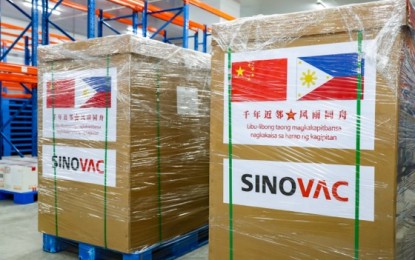
SINOVAC VAX. The first batch of China-donated Sinovac’s CoronaVac vaccines arrives in Manila on Feb. 28, 2021. Malacañang on Wednesday (June 2, 2021) welcomed the World Health Organization’s validation of China's Sinovac-CoronaVac Covid-19 vaccine for emergency use, saying the development is expected to boost confidence among those hesitant to receive non-western vaccine brands. (Photo courtesy of China Embassy)
MANILA – Malacañang on Wednesday welcomed the World Health Organization’s (WHO) validation of China's Sinovac-CoronaVac Covid-19 vaccine for emergency use, saying the development is expected to boost confidence among those hesitant to receive non-western vaccine brands.
Presidential Spokesperson Harry Roque said the Palace is pleased that WHO now joins other institutions in giving its stamp of approval that assesses the quality, safety, and efficacy of Covid-19 vaccines.
“Nagagalak po ako sa balitang yan dahil yan po ay siguradong makaka-boost ng kumpyansa sa bakuna dahil nadagdagan po yung mga institusyon na nagsabi na ligtas at epektibo ang Sinovac na pinakamaraming ginagamit natin sa Pilipinas (I'm happy with that news because it will definitely boost confidence in the vaccine because another is added to the list of institutions that say Sinovac, now widely used in the Philippines, is safe and effective," he said in an interview over PTV-4.
The WHO’s emergency use listing (EUL) of Sinovac comes three months after the Food and Drug Administration (FDA) of the Philippines cleared the Chinese Covid-19 vaccine brand for emergency use in February.
“Ngayon po hindi lang po FDA ng Pilipinas ang nagsabi na ligtas at epektibo ang Sinovac pati na rin po ang ating WHO dahil yun po ang ibig sabihin kapag nakasama sa emergency use list ng WHO (Now, it is not only the FDA of the Philippines that says that Sinovac is safe and effective, WHO now included because that’s what it means when it is in the emergency use list),” he added.
Roque, meanwhile, expressed confidence that after WHO’s EUL, more Filipinos will be willing to get inoculated with Sinovac.
“Talaga naman pong makakatulong po ‘to para maitaas ang kumpyansa sa bakuna dahil ito po’y karagdagan assurance ng isang UN-agency na ligtas at epektibo ang Sinovac (This will definitely help to increase confidence in the vaccine because it is an additional assurance from a UN-agency that Sinovac is safe and effective),” he said.
WHO’s EUL is a prerequisite for COVAX Facility vaccine supply and international procurement. It also allows countries to expedite their own regulatory approval to import and administer Covid-19 vaccines.
Based on available evidence, WHO recommends the vaccine for use in adults 18 years and older, in a two-dose schedule with a spacing of two to four weeks.
Vaccine efficacy results showed that the vaccine prevented symptomatic disease in 51 percent of those vaccinated and prevented severe Covid-19 and hospitalization in 100 percent of the studied population.
WHO recommends that countries using the vaccine in older age groups conduct safety and effectiveness monitoring to verify the expected impact and contribute to making the recommendation more robust for all countries.
With the delivery of the first batch of China’s donated Sinovac-CoronaVac vaccines, the Philippines was able to kick off its vaccination drive on March 1.
The Philippines has so far received 5.5 million Sinovac jabs, including 4.5 million doses procured by the national government for its free vaccination program.
Besides Sinovac-CoronaVac, the country now has three other brands in its inventory namely AstraZeneca (UK), Sputnik V (Russia), and Pfizer (US).
The Philippines aims to achieve “population protection” by vaccinating 50 to 60 percent of the population with a concentration in Metro Manila, two other cities, and six provinces by November this year. (PNA)
